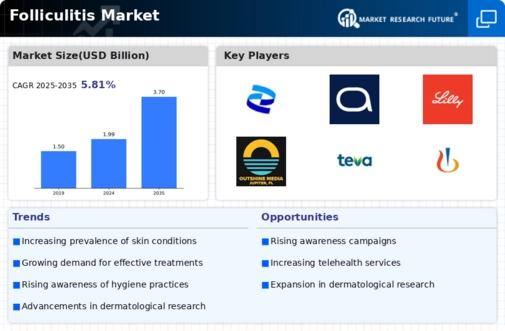Impact of Lifestyle Changes
Lifestyle changes are playing a crucial role in shaping the Folliculitis Market. Factors such as increased stress levels, dietary habits, and hygiene practices can influence the occurrence of folliculitis. For instance, the consumption of processed foods and high-sugar diets may exacerbate skin conditions, leading to a higher incidence of folliculitis. Additionally, the trend towards more sedentary lifestyles can contribute to skin issues, prompting individuals to seek effective treatments. As awareness of the link between lifestyle and skin health grows, there is a potential for increased demand for products that address folliculitis. This shift may drive innovation within the Folliculitis Market, as companies strive to develop solutions that cater to the needs of health-conscious consumers.
Advancements in Treatment Modalities
Innovations in treatment modalities are significantly influencing the Folliculitis Market. The development of new topical and systemic therapies, including antibiotics and antifungal agents, has enhanced treatment efficacy. Recent studies indicate that targeted therapies can reduce the duration and severity of folliculitis episodes. Additionally, the introduction of combination therapies is gaining traction, as they may offer improved outcomes for patients. This evolution in treatment options not only addresses the immediate needs of patients but also fosters a competitive landscape among pharmaceutical companies. As a result, the Folliculitis Market is likely to witness increased investment in research and development, leading to more effective solutions for managing this condition.
Increasing Incidence of Folliculitis
The rising incidence of folliculitis is a notable driver in the Folliculitis Market. Factors such as increased exposure to irritants, allergens, and bacteria contribute to this trend. According to health statistics, skin infections, including folliculitis, have shown a steady increase, with millions affected annually. This growing prevalence necessitates effective treatment options, thereby propelling the demand for therapeutic products. As awareness of skin conditions rises, patients are more likely to seek medical advice and treatment, further stimulating market growth. The Folliculitis Market is thus positioned to expand as healthcare providers and patients alike prioritize effective management of this common skin condition.
Rising Interest in Preventive Healthcare
The rising interest in preventive healthcare is significantly impacting the Folliculitis Market. Consumers are increasingly prioritizing proactive measures to maintain skin health and prevent conditions like folliculitis. This trend is reflected in the growing popularity of preventive skincare products, which aim to reduce the risk of skin infections. Market Research Future indicates that consumers are more inclined to invest in products that offer protective benefits, such as antimicrobial and anti-inflammatory properties. As a result, companies within the Folliculitis Market are likely to focus on developing preventive solutions that align with this consumer shift. This emphasis on prevention could lead to a broader range of products designed to mitigate the risk of folliculitis, ultimately enhancing market growth.
Growing Demand for Dermatological Products
The escalating demand for dermatological products is a key driver in the Folliculitis Market. Consumers are increasingly seeking specialized skincare solutions that address specific skin concerns, including folliculitis. Market data suggests that the dermatological segment is experiencing robust growth, with a significant portion of consumers willing to invest in high-quality products. This trend is further fueled by the rise of social media influencers and dermatologists advocating for effective skincare routines. As consumers become more educated about skin health, the demand for products that prevent and treat folliculitis is expected to rise. Consequently, the Folliculitis Market is poised for expansion as brands innovate to meet these evolving consumer preferences.

















Leave a Comment